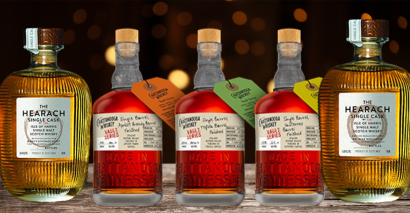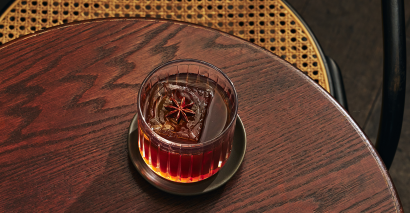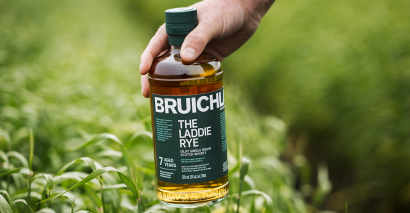
Shelter Point Distillery operations manager James Marinus.
Of Canadian whisky, legendary whisky writer Michael Jackson once wrote, “Whatever their labels say, all Canadian whiskies are of the same style.”
While that may have been true in 1987, when Jackson penned those words in his “World Guide to Whisky,” one needn’t be a whisky expert to know that things are much different today. Not only are the ranks of Canadian whiskies now populated by a large number of straight ryes—a style that Jackson bemoaned as “a shame” that Canada lacked them in his day—and all sorts of other whisky types, including ersatz “bourbons,” triple distilled whiskies inspired by the Irish tradition, and a steadily growing coterie of single malts.
It is in that final camp that Canadian whisky may have its greatest potential.
“We have some of the best grain growers on the planet,” says Tyler Dyck, CEO of British Columbia’s Okanagan Spirits Craft Distillery, “If they’re providing us with great grains, well, it’s like being a chef with great ingredients—it’s beholden upon us to use those grains to make great products.”
 Glenora Distillery is located on Cape Breton Island, Nova Scotia.
Glenora Distillery is located on Cape Breton Island, Nova Scotia.
Dyck is not alone in championing the merits of his country’s barley. From Lauchie MacLean, president of Glenora Distillers in Nova Scotia, to David Farran, president of Eau Claire Distillery in Alberta, and Graeme Macaloney, founder of Macaloney’s Caledonian Distillery on Vancouver Island in British Columbia, single malt whisky makers across Canada are effusive in their praise of the country’s barley, and cite it among the major factors separating Canadian single malt whisky from the pack.
“Canadian barley is way superior to British barley,” argues Macaloney, “and I say this not just as a whisky distiller, but also as a Ph.D. fermentation microbiologist.” The difference, he says, is in the starch content, which is “much higher” in British barley than in Canadian. “High-starch barley translates into much larger yields in terms of alcohol per metric ton,” explains Macaloney, “I get much smaller yields [using Canada-grown barley], but I think it translates into the quality of the whisky.”
Beyond quality, barley is also one of the defining elements of a whisky’s terroir, according to some distillers. “Canadian barley is diverse,” says Dyck, “The barley grown near us is much different from even the barley grown in the Peace River valley (roughly 600 miles away). What’s most exciting to me is when distilleries are using grain that’s not just Canadian, but grown in the vicinity of the distillery.”
Taking that approach to the extreme is Shelter Point Distillery on Vancouver Island, where distillery manager Jacob Wiebe says roughly 35% of his barley is grown on the distillery farm. “Our aim is to eventually have a 50-50 split between our barley and what we source from small [Canadian] maltsters like Gambrinus,” he says. “One reason we’re not there yet is that it’s very difficult to farm on the coast. One year we had a big rainstorm early in the season that knocked out half our crop.”
Geography doesn’t only figure into the nature and quality of barley crops. Numerous Canadian distillers report a significant impact of their locale on the aroma and flavor of their whisky.
From the approximately 4,000-foot altitude of Eau Claire to the extreme coastal location of Macaloney’s—“We’re not much further than a mile from the coast in any direction”—to the several hundred apple trees and many thousand maples growing on the 700 acres of land upon which Glenora sits, geography and climate have an outsized impact upon the development of Canadian single malts, perhaps more so than in any of the world’s traditional whisky regions, suggest several distillers.
“We do no temperature control of our warehouses, and we live in this wacky climate that can go from -22ºF to 50ºF in a single day,” says Farran. “Coupled with our altitude, the result is that we actually lose more water than alcohol in our angels’ share.”
Outsized angels’ shares, albeit more of spirit than water, are cited by other Canadian whisky distillers, with coastal location, altitude, or dry or highly variable conditions resulting in annual losses of up to 8%. It’s a big penalty, says Macaloney, but it comes with a big benefit.
“(Late distilling legend) Jim Swan said to me, ‘Don’t worry about the angels’ share, because it works out in greater maturity at a younger age,’” he recalls.
Beyond good grain and geography, Canada’s single malt distillers have a few other tricks up their sleeves, be it the ice wine barrels Glenora used to make the world’s first ice wine-aged single malt in 2008 and continues to use today, the Single Farm Whisky project underway at Ontario’s Last Straw Distillery, or the two metric- ton (2.2 U.S. tons) smoking unit Macaloney commissioned so that he might custom-smoke his malt with locally sourced peat.
While quantities of Canadian single malt may be relatively small at present, they are currently aging at at least two dozen distilleries across the country. Many are from single malt-focused operations like British Columbia’s Dubh Glas, that for now remains modest enough that their malts sell out almost immediately upon release. Add to that the statements by such Canadian whisky mavens as Hiram Walker’s Dr. Don Livermore, who notes the single malts aging in the whisky giant’s warehouses remain “years away” from release, and it seems entirely possible that, inside of a decade, the world may be hearing a lot more about Canadian single malt whiskies.
4 Canadian Single Malts to Try

Eau Claire (Batch 005), 43%, $75
The high altitude of the Turner Valley in Alberta, along with severe winters that can turn overnight into springlike conditions due to winds known as Chinook, mean that this whisky ages quickly and variably. This batch highlights the impact of the increased use of sherry barrels, with cherry and vanilla on the nose and rich grain and stone fruit influences on the palate.

Glen Breton Rare 14 year old, 43%, $105
This whisky was initially released as an 8 year old in 2000. Its distillery, Glenora, is housed alongside an inn on picturesque Cape Breton Island in Nova Scotia, and is the country’s most prolific producer of single malts. Its best-seller is this mature spirit with a floral, almost green apple aroma and a rich, dry, fruity palate with a touch of maritime tang. Available online only at glenoradistillery.com

Macaloney’s Caledonian Glenloy, 46%, $86
Inspired by its founder’s Scottish roots– Macaloney was born in Scotland and also studied fermentation and distillation there–this distillery is Vancouver Island proud, even decorating its boxes and labels with Island scenes. Aged in four types of barrels, including oloroso and Pedro Ximénez sherry casks, this is the distillery’s flagship and offers marmalade, fruit, spice, and a long finish Available at victoriacaledonian.com

Shelter Point Artisanal, 46%, $80
A true farm distillery, Shelter Point can claim agrarian and coastal influence, with a warehouse barely more than a half-mile from the shore. Coupled with the coastal impact upon the farm, which supplies roughly one-third of the barley used, the result is a whisky that alternates between maritime salinity and grain-field freshness on the nose, with mellow fruitiness and brown spice on the palate. California only




